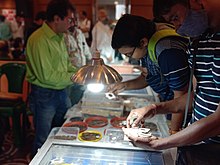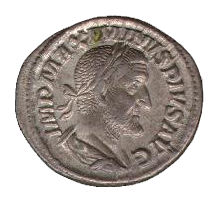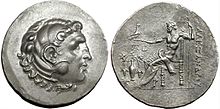Numismatics
| Part ofa serieson |
| Numismatics the study of currency |
|---|
 |
Numismaticsis the study or collection ofcurrency,including coins, tokens, paper money, medals and related objects.
Specialists, known asnumismatists,are often characterized as students or collectors ofcoins,but the discipline also includes the broader study ofmoneyand other means ofpaymentused to resolvedebtsand exchangegoods.

The earliest forms of money used by people are categorised by collectors as "odd and curious",[1]but the use of other goods in barter exchange is excluded, even where used as a circulatingcurrency(e.g.,cigarettesorinstant noodlesin prison).[2]As an example, theKyrgyz peopleusedhorsesas the principal currency unit, and gave small change inlambskins;[3]the lambskins may be suitable for numismatic study, but the horses are not.[dubious–discuss]Many objects have been used for centuries, such ascowry shells,precious metals,cocoa beans,large stones,andgems.
Etymology[edit]
First attested in English in 1829, the wordnumismaticscomes from the adjectivenumismatic,meaning'of coins'.It was borrowed in 1792 fromFrenchnumismatique,itself a derivation fromLate Latinnumismatis,genitive ofnumisma,a variant ofnomismameaning'coin'.[4][5]Nomismais alatinisationof theGreekνόμισμα(nomisma) which means'current coin/custom',[6]which derives fromνομίζειν(nomizein)'to hold or own as a custom or usage, to use customarily',[7]in turn fromνόμος(nomos)'usage, custom',[8]ultimately fromνέμειν(nemein)'to dispense, divide, assign, keep, hold'.[9]
History of money[edit]
Throughout its history, money itself has been made to be ascarcegood, although it does not have to be.[citation needed]Many materials have been used to form money, from naturally scarceprecious metalsandcowry shellsthroughcigarettesto entirely artificial money, calledfiat money,such asbanknotes.Many complementary currencies use time as a unit of measure, using mutual credit accounting that keeps the balance of money intact.
Modern money (along with most ancient money) is essentially a token – an abstraction. Paper currency is perhaps the most common type of contemporary physical money. However, goods such asgoldorsilverretain many of the essential properties of money, such as price fluctuation and limited supply, although these goods are not controlled by one single authority.
History of numismatics[edit]

Coin collectingmay have possibly existed in ancient times.Augustusgave "coins of every device, including old pieces of the kings and foreign money" asSaturnaliagifts.[10]
Petrarch,who wrote in a letter that he was often approached by vine diggers with old coins asking him to buy or to identify the ruler, is credited as the firstRenaissancecollector. Petrarch presented a collection of Roman coins toEmperor Charles IVin 1355.
The first book on coins wasDe Asse et Partibus(1514) byGuillaume Budé.[11]During the early Renaissance ancient coins were collected by European royalty and nobility. Collectors of coins were PopeBoniface VIII,EmperorMaximilianof the Holy Roman Empire,Louis XIVof France, Ferdinand I, ElectorJoachim IIof Brandenburg who started the Berlin coin cabinet andHenry IV of Franceto name a few. Numismatics is called the "Hobby of Kings", due to its most esteemed founders.
Professional societies organised in the 19th century. TheRoyal Numismatic Societywas founded in 1836 and immediately began publishing the journal that became theNumismatic Chronicle.TheAmerican Numismatic Societywas founded in 1858 and began publishing theAmerican Journal of Numismaticsin 1866.
In 1931 theBritish Academylaunched theSylloge Nummorum Graecorumpublishing collections ofAncient Greek coinage.The first volume ofSylloge of Coins of the British Isleswas published in 1958.
In the 20th century, coins gained recognition as archaeological objects, and scholars such asGuido Bruckof the Kunsthistorisches Museum in Vienna realized their value in providing a temporal context and the difficulty that curators faced when identifying worn coins using classical literature. AfterWorld War IIin Germany, a project,Fundmünzen der Antike(Coin finds of the Classical Period) was launched to register every coin found within Germany. This idea found successors in many countries.
In the United States, the US Mint established a coin cabinet in 1838 when chief coinerAdam Eckfeldtdonated his personal collection.[12]William E. Du Bois'Pledges of History...(1846) describes the cabinet.
C. Wyllys Betts'American colonial history illustrated by contemporary medals(1894) set the groundwork for the study of American historical medals.
Helen Wang's "A short history of Chinese numismatics in European languages" (2012–2013) gives an outline history of Western countries' understanding of Chinese numismatics.[13]Lyce Jankowski'sLes amis des monnaiesis an in-depth study of Chinese numismatics in China in the 19th century.[14]
Modern numismatics[edit]

Modern numismatics is the study of the coins of the mid-17th century onward, the period of machine-struck coins.[15]Their study serves more the need of collectors than historians, and it is more often successfully pursued by amateur aficionados than by professional scholars. The focus of modern numismatics frequently lies in the research of production and use of money in historical contexts using mint or other records in order to determine the relative rarity of the coins they study. Varieties,mint-made errors,the results of progressive die wear, mintage figures, and even the sociopolitical context of coin mintings are also matters of interest.
Subfields[edit]
Exonumia(UK English: Paranumismatica)[16]is the study ofcoin-like objects such astoken coinsandmedals,and other items used in place of legal currency or for commemoration. This includeselongated coins,encased coins, souvenir medallions, tags, badges, counter-stamped coins,wooden nickels,credit cards,and other similar items. It is related to numismatics proper (concerned with coins which have beenlegal tender), and manycoin collectorsare also exonumists.
Notaphilyis the study ofpaper moneyor banknotes. It is believed that people have been collecting paper money for as long as it has been in use. However, people only started collecting paper money systematically in Germany in the 1920s, particularly theSerienscheine(Series notes)Notgeld.The turning point occurred in the 1970s when notaphily was established as a separate area by collectors. At the same time, some developed countries such as theUnited States,Germany,andFrancebegan publishing their respective national catalogs of paper money, which represented major points of reference literature.

Scripophilyis the study and collection of companies' shares andbondscertificates. It is an area of collecting due to both the inherent beauty of some historical documents as well as the interesting historical context of each document. Some stock certificates are excellent examples ofengraving.Occasionally, an old stock document will be found that still has value as stock in a successor company.
See also[edit]
Further reading[edit]
- Krmnicek Stefan and Hadrien Rambach. (2023).The Numismatic World in the Long Nineteenth Century.New York: Routledge Taylor & Francis Group.
- Pritsak, O. (1998).The Origins of the Old Rus’ Weights and Monetary Systems: Two Studies in Western Eurasian Metrology and Numismatics in the Seventh to Eleventh Centuries(Harvard Series In Ukrainian Studies). Cambridge: Harvard Ukrainian Research Institute.[17][18]
References[edit]
- ^Maurer, B. "Primitive and Nonmetallic Money". In Yago, K.; Battilosi, S.; Cassis., Y. (eds.).Handbook of the History of Money and Currency.Springer. p. 87-104.
- ^Gibson-Light, Michael (2018-06-01)."Ramen Politics: Informal Money and Logics of Resistance in the Contemporary American Prison".Qualitative Sociology.41(2): 199–220.doi:10.1007/s11133-018-9376-0.ISSN1573-7837.S2CID254976793.
- ^Glyn Davies (1996).Chronology of Money 1900 — 1919.University of Wales Press.ISBN978-0-7083-1351-0.Archivedfrom the original on 2006-07-14.Retrieved2006-08-09.
- ^Harper, Douglas."numismatics".Online Etymology Dictionary.
- ^nomisma.Charlton T. Lewis and Charles Short.A Latin DictionaryonPerseus Project.
- ^νόμισμα.Liddell, Henry George;Scott, Robert;A Greek–English Lexiconat thePerseus Project.
- ^νομίζεινinLiddellandScott.
- ^νόμοςinLiddellandScott.
- ^νέμεινinLiddellandScott.
- ^Suetonius,Augustus75 on-line textArchived2022-07-31 at theWayback Machine
- ^Brigham Young Universitylibrary web pageArchived2008-07-25 at theWayback Machine
- ^Kent, Allen (1985).Encyclopedia of Library and Information Science.p. 281.ISBN978-0-8247-2037-7.
- ^Helen Wang,"A short history of Chinese numismatics in European languages", inEarly Chinavols 35-36 (2012–2013), pp. 395-429,
- ^Jankowski, Lyce (2018).Les amis des monnaies – la sociabilité savante des collectionneurs et numismates chinois de la fin des Qing.Paris: Maisonneuve et Larose nlle édition.ISBN978-2-37701-030-1.
- ^"Collectibles".Maritime International.Archivedfrom the original on September 14, 2013.RetrievedJune 13,2013.
- ^The First Dictionary of Paranumismatica: All About Tokens, Checks, Tickets, Passes, Medalets, Counters, Tallies and Weights (ed. Brian Edge), 1991.ISBN978-0951691007
- ^Noonan, Thomas S. (1999). "Reviewed work: The Origins of the Old Rus' Weights and Monetary Systems: Two Studies in Western Eurasian Metrology and Numismatics in the Seventh to Eleventh Centuries, Omeljan Pritsak".The Russian Review.58(2): 319–320.JSTOR2679589.
- ^Hellie, Richard (1999). "Reviewed work: The Origins of the Old Rus' Weights and Monetary Systems: Two Studies in Western Eurasian Metrology and Numismatics in the Seventh to Eleventh Centuries, Omeljan Pritsak".Slavic Review.58(4): 909–910.doi:10.2307/2697226.JSTOR2697226.
External links[edit]
 The dictionary definition ofnumismaticsat Wiktionary
The dictionary definition ofnumismaticsat Wiktionary Media related toNumismaticsat Wikimedia Commons
Media related toNumismaticsat Wikimedia Commons




